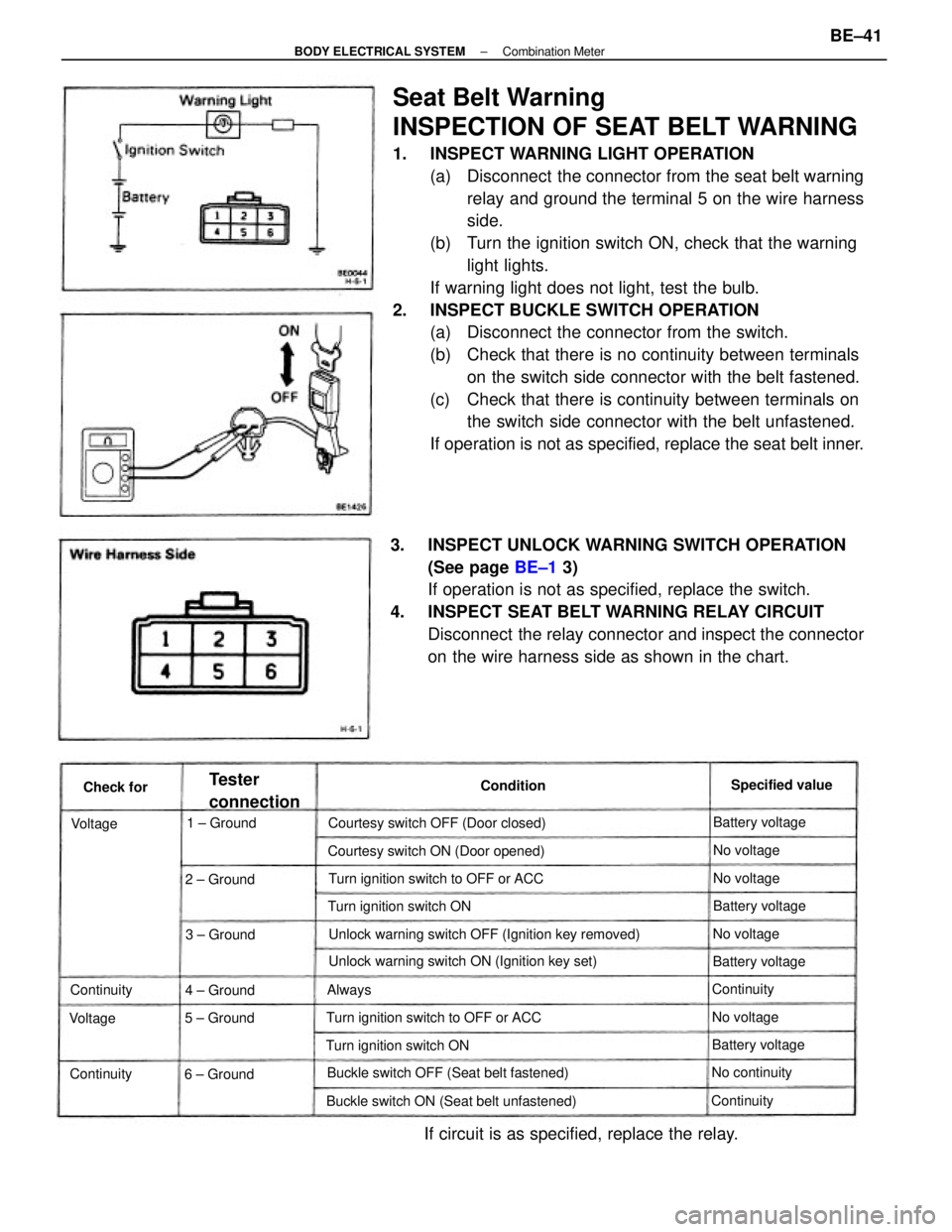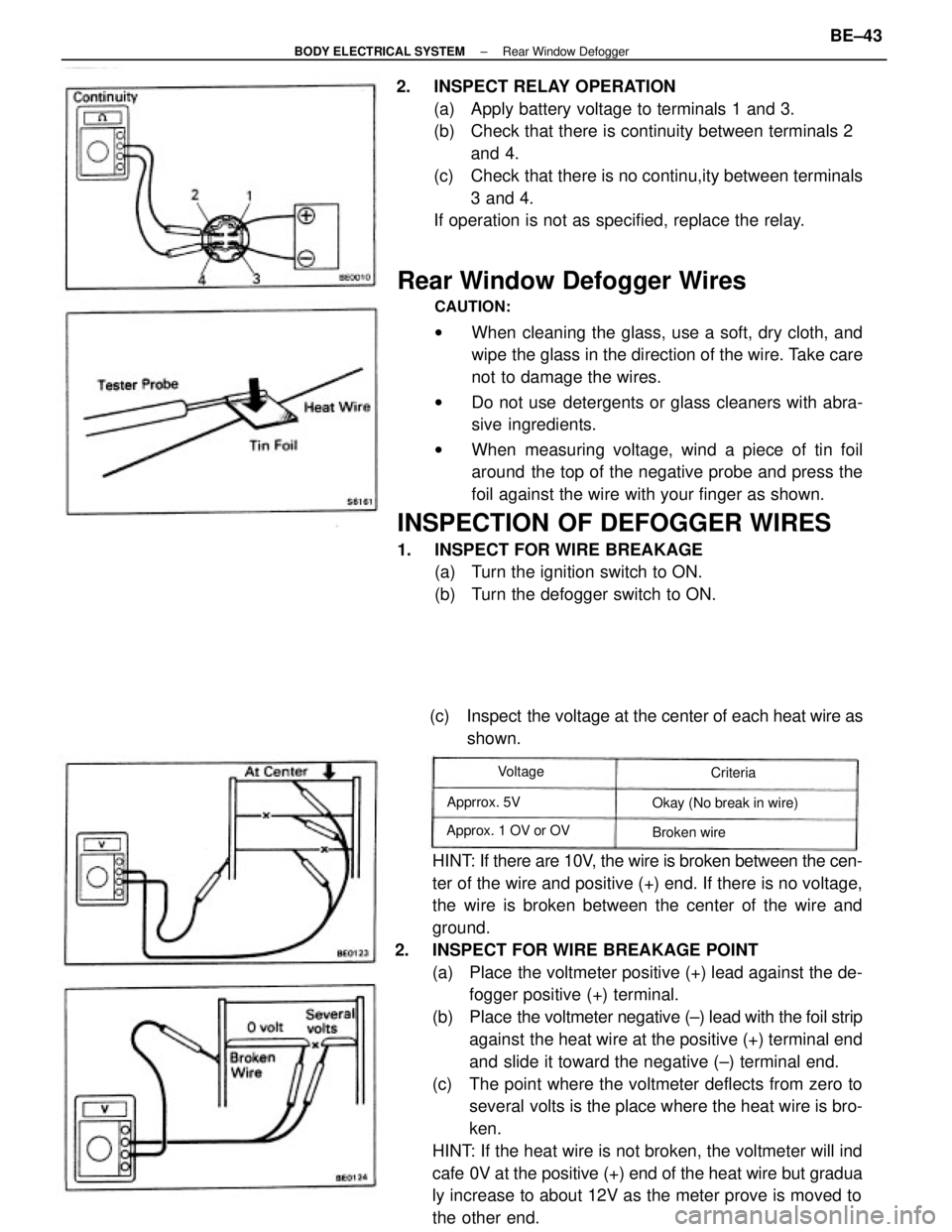Page 775 of 2389

Rear Wiper Motor and Relay
INSPECTION OF MOTOR AND RELAY
1. INSPECT RELAY AND MOTOR OPERATES
(a) Connect the positive (+) lead from the battery to terminal
1 and negative (±) leads to both terminal 3 and
motor body.
(b) Check that the motor operates.
2. INSPECT INTERMITTENT OPERATION OF RELAY
(a) Connect the positive 1+y lead from the battery to ter-
minal 1 and negative t±) leads to both terminal 2 and
motor body.
(b) Check that the motor operates intermittently for 9
15 seconds.
If operation is not as specified, replace the relay.
3. INSPECT MOTOR OPERATES, STOPPING AT STOP
POSITION
(a) Start motor operation by connecting the positive (+j
lead from the battery to terminal 1 and the negative (±
lead to both terminal 3 and motor body.
Rear Wiper and Washer Switch
INSPECTION OF SWITCH
INSPECT SWITCH CONTINUITY
Inspect the switch continuity between terminals.
If continuity is not as specified, replace the switch.
Switch position
Terminal
Wash ll
Wash IOFF INT
± BODY ELECTRICAL SYSTEMWipers and WashersBE±29
Page 776 of 2389
(e) Connect the positive (+) lead from the battery to ter-
minal 1 and the negative (±) lead to the motor body.
(d) Check that the motor stops running at the stop posi-
tion after the motor operates again.
If operation is not as specified, replace the motor.
± BODY ELECTRICAL SYSTEMWipers and WashersBE±30
Page 783 of 2389

Fuel Level Warning
INSPECTION OF LEVEL WARNING
1. INSPECT WARNING LIGHT OPERATION
(a) Disconnect the connector from the sender gauge.
(b) Connect terminals 1 and 2 on the wire harness side-
connector.
(e) Turn the ignition switch ON, check that the warning
light lights.
If the warning light does not light, test the bulb.
2. INSPECT WARNING SWITCH OPERATION
(a) Apply battery voltage to terminals 1 and 2 through a
3.4W test bulb, check that the bulb lights.
HINT: It will take a short time for the bulb to light.If resistance value is not as specified, replace the receiver
gauge.
3. INSPECT SENDER GAUGE OPERATION
(a) Connect a series of three 1.5V dry cell batterys.
(b) Connect the positive (+) lead from the dry cell batter-
ys to terminal 3 through a 3.4W test bulb and the neg-
ative (±) lead to terminal 4.
(c) Check that the voltage rises between terminals 3 and
4 as the float is moved from the top to bottom posi-
tion. 2. MEASURE RECEIVER GAUGE RESISTANCE
Measure the resistance between terminals.
(d) Measure the resistance between terminals 3 and 4
for each float position.
If operation is not as specified, replace the sender
gauge.
Between terminals
Resistance (W)
Resistance (W)
All±Trac/4WD Float position
mm (in.)
FWD
± BODY ELECTRICAL SYSTEMCombination MeterBE±37
Page 787 of 2389

Seat Belt Warning
INSPECTION OF SEAT BELT WARNING
1. INSPECT WARNING LIGHT OPERATION
(a) Disconnect the connector from the seat belt warning
relay and ground the terminal 5 on the wire harness
side.
(b) Turn the ignition switch ON, check that the warning
light lights.
If warning light does not light, test the bulb.
2. INSPECT BUCKLE SWITCH OPERATION
(a) Disconnect the connector from the switch.
(b) Check that there is no continuity between terminals
on the switch side connector with the belt fastened.
(c) Check that there is continuity between terminals on
the switch side connector with the belt unfastened.
If operation is not as specified, replace the seat belt inner.
3. INSPECT UNLOCK WARNING SWITCH OPERATION
(See page BE±1 3)
If operation is not as specified, replace the switch.
4. INSPECT SEAT BELT WARNING RELAY CIRCUIT
Disconnect the relay connector and inspect the connector
on the wire harness side as shown in the chart.
Unlock warning switch OFF (Ignition key removed)
If circuit is as specified, replace the relay.
Unlock warning switch ON (Ignition key set)
Buckle switch ON (Seat belt unfastened)Buckle switch OFF (Seat belt fastened)Courtesy switch ON (Door opened)
Turn ignition switch to OFF or ACCTurn ignition switch to OFF or ACC Courtesy switch OFF (Door closed)
Turn ignition switch ONTurn ignition switch ON
6 ± Ground
Tester
connectionSpecified value
Battery voltage
Battery voltage
Battery voltageBattery voltage
No continuity 1 ± Ground
2 ± Ground
3 ± Ground
5 ± Ground4 ± GroundContinuity
Continuity
ContinuityNo voltageNo voltageNo voltage
No voltage
Continuity Condition
Check for
VoltageVoltage
Always
± BODY ELECTRICAL SYSTEMCombination MeterBE±41
Page 788 of 2389

Rear Window Defogger Switch
INSPECTION OF SWITCH
INSPECT SWITCH OPERATION
(a) Connect the positive (+) lead from the battery to
terminal 2 and the negative (±) lead to terminal 3.
(b) Connect terminals 2 and 6 through a 3.4 W test bulb.
(e) Push the defogger switch. Check that the test bulb
lights for 12 to 18 minutes, then the test bulb goes
out.
If operation is not as specified, replace the switch.
Rear Window Defogger Relay
INSPECTION OF RELAY
1. INSPECT RELAY CONTINUITY
(a) Check that there is continuity between terminals 1
and 3.
(b) Check that there is no continuity between terminals 2
and 4.
(e) Check that there is no continuity between terminals 3
and 4.
If continuity is not as specified, replace the relay.
Reset breaker and check for short
Replace fuse and check for short
Check switch
Check relay
Check wires
Repair as necessary
REAR WINDOW DEFOGGER
Troubleshooting
Circuit breaker OFF
GAUGE fuse blown
Defogger switch faulty
Defogger relay faulty
Defogger wire broken
Wiring and ground faulty Rear window defogger
does not work.BE±3
BE±3
BE±42
BE±42
BE±43 Possible cause Problem
Remedy
Page
± BODY ELECTRICAL SYSTEMRear Window DefoggerBE±42
Page 789 of 2389

Rear Window Defogger Wires
CAUTION:
wWhen cleaning the glass, use a soft, dry cloth, and
wipe the glass in the direction of the wire. Take care
not to damage the wires.
wDo not use detergents or glass cleaners with abra-
sive ingredients.
wWhen measuring voltage, wind a piece of tin foil
around the top of the negative probe and press the
foil against the wire with your finger as shown.
INSPECTION OF DEFOGGER WIRES
1. INSPECT FOR WIRE BREAKAGE
(a) Turn the ignition switch to ON.
(b) Turn the defogger switch to ON.
HINT: If there are 10V, the wire is broken between the cen-
ter of the wire and positive (+) end. If there is no voltage,
the wire is broken between the center of the wire and
ground.
2. INSPECT FOR WIRE BREAKAGE POINT
(a) Place the voltmeter positive (+) lead against the de-
fogger positive (+) terminal.
(b) Place the voltmeter negative (±) lead with the foil strip
against the heat wire at the positive (+) terminal end
and slide it toward the negative (±) terminal end.
(c) The point where the voltmeter deflects from zero to
several volts is the place where the heat wire is bro-
ken.
HINT: If the heat wire is not broken, the voltmeter will ind
cafe 0V at the positive (+) end of the heat wire but gradua
ly increase to about 12V as the meter prove is moved to
the other end. 2. INSPECT RELAY OPERATION
(a) Apply battery voltage to terminals 1 and 3.
(b) Check that there is continuity between terminals 2
and 4.
(c) Check that there is no continu,ity between terminals
3 and 4.
If operation is not as specified, replace the relay.
(c) Inspect the voltage at the center of each heat wire as
shown.
Okay (No break in wire)
Approx. 1 OV or OVApprrox. 5V
Broken wire Voltage
Criteria
± BODY ELECTRICAL SYSTEMRear Window DefoggerBE±43
Page 794 of 2389
Heater Relay
INSPECTION OF RELAY
1. INSPECT RELAY CONTINUITY
(a) Check that there is continuity between terminals 1
and 3.
(b) Check that there is continuity between terminals 2
and 4.
(e) Check that there is no continuity between terminals
4 and 5.
If continuity is not as specified, replace the relay.
2. INSPECT RELAY OPERATION
(a) Apply battery voltage to terminals 1 and 3.
(b) Check that there is continuity between terminals 4
and 5.
(e) Check that there is no continuity between terminals
2 and 4.
If operation is not as specified, replace the relay.
Heater Blower Resistor
INSPECTION OF RESISTOR
INSPECT RESISTOR CONTINUITY
(Levertype)
Check that there is continuity between terminals 1 and 3.
If there is no continuity, replace the resistor.
(Push type)
Check that there is continuity between terminals 5 and ^.
If there is no continuity, replace the resistor.
± BODY ELECTRICAL SYSTEMHeaterBE±48
Page 795 of 2389

2. INSPECT INDICATOR LIGHT OPERATION
(a) Connect the positive (+) lead from the battery to
terminal A7 and negative (±) lead to terminal Al 7.
(b) With the blower button pushed in, check that the indi-
cator light is lit. (The indicator light will not go on
when the blower button is in the OFF position.)
(c) With the RECIRC button pushed in, check that the
indicator light is lit.
(d) Next, push the FRESH button in, check that the indi-
cator light is lit and the RECIRC indicator light goes
off.
(e) Press each of the mode buttons in and check that
their indicator lights go on.
If operation is not as specified, replace the heater control.
Heater Control Assembly
(Push Type)
INSPECTION OF HEATER CONTROL ASSEMBLY
1. MEASURE TEMPERATURE CONTROL LEVER
RESISTANCE
Measure the resistance between terminals A1 and A9 for each
lever position.
3. INSPECT BLOWER SWITCH CONTINUITY
Inspect the blower switch continuity between terminals.If each resistance value is not as shown in the table
above, replace the heater control assembly.
If continuity is not as specified, replace the heater control.
Resistance (k�) Lever position
Switch
position
Max. Warm
Max Coo!
A17 Terminal Middle
OFF
. B6
± BODY ELECTRICAL SYSTEMHeaterBE±49